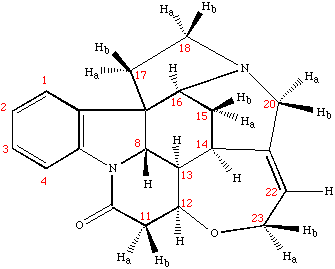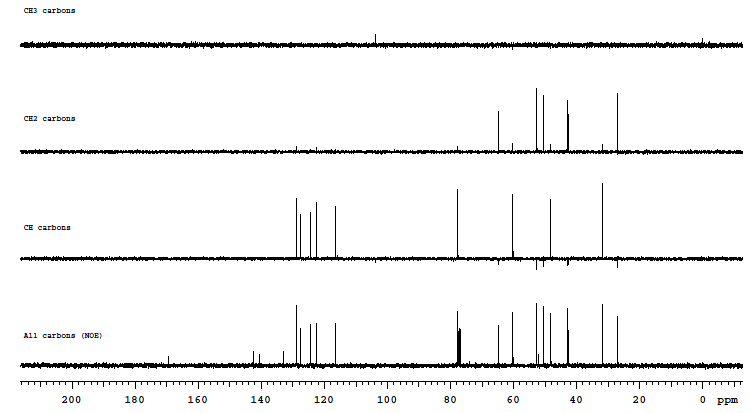DEPTNOE
DEPTNOE is an in-house written macro that carries DEPT and NOE-enhanced C13
detection (all C13 signals are detected) in one experiment. Refer to the DEPT instruction for details on DEPT. The macro is
meant to be used for automated data collection, processing and printing
processes (remember to enter au, not go or
ga to start experiment). Manual parameter control is possible,
as instructed below.
In the {H1}C13 NOE experiment, broadband H1 decoupling is applied during the
recycle delay in addition to that during the acquisition period to enhance the
H1-attached C13 signals.
Note:
- You are strongly recommended to tune both H1 and C13
channels. DEPT requires accurate 90 degree 1H and to a lesser
degree 13C 90 degree pulse width to give a clean editing results.
C13 referencing
- For accurate C13 referencing, add TMS or DSS (in aqueous solution) to
your deuterated solvent. Use 1H signal from TMS or DSS for 0.0ppm reference
and C13 is indirectly referenced according to IUPAC
standard .
- For rough referencing with the lock signal, simply type
setref.
Procedure (on NMR500 with SWP probe)
deptnoe macro
- This is a macro written a while ago for the same experiment. After
deptnoe is entered, the experiment starts immediately
using default parameters. Type stop to abort the
experiment if signal is satisfactory. Follow the printing instruction
below.
- Please use the new procedure below and tune the H1 (use channel
2) and C13 X-channel (use channel 1) before
starting the experiment. For tuning purpose, you can simply type
tn='C13' dn='H1' su under any experiment before
tuning.
Step 1: Tune, lock and shim
- Turn ON temperature regulation (default on nmr500
at 22C)
- Turn OFF spinning
- Under exp2 (type jexp2 to join exp2):
- Type initshims to reset shim
values
- Type setexp('deptnoe') to load
parameters.
- Change solvent, lock and shim Z1/Z2 then X1/Y1 and then readjust Z1/Z2.
Keep lock level at ~80%.
- Tune both 1H channel and X-channel for 13C. This is
critical for clean editing results.
- Type su in exp2 before
tuning
- Tune 1H channel (channel 2)
- Tune X-channel (channel 1) to C13. No tuning
stick is needed.
- Check 1/4-wavelength cable on broadband preamp.
Make sure it is for C13.
Step 2: Start experiment
- Type au to start experiment with default parameters.
- Experiment starts in interleaved mode with
bs=16. In the this mode, each of the five elements of the
array is run bs scans and then the cycle starts from the
1st element again for another bs scans. Each cycle takes ~
2.2 mins.
- Stop the experiments by typing stop whenever you feel
the sensitivity is sufficient. DO NOT use aa or click the
Abort Acquisition button. Doing so may terminate the data
acquisition in the middle of the array, making the intensity uneven among
array elements.
Step 4: Processing and printing
- Check during data collection:
- Type pldeptnoe2 to process data
and display spectra on screen. Note only DEPT (the 1st four elements) is
processed and displayed. To display the all-C13 spectrum, simply type
wft(5) f full aph.
- Type pldeptnoe to process and
print spectra to printer. Processing and printing starts after the current
array cycle finishes. Both processed DEPT and all-C13 spectrum are
printed.
- After data collection:
- Type pldeptnoe2 page to print to
printer. Both processed DEPT and all-C13 spectra are printed.
- Type pldeptnoe2('deptnoe.pdf')
or pldeptnoe2('deptnoe.jpg') to print to a .pdf or .jpg
file under your current folder. Type pwd to see what is
the current folder. See this page, for
more on printing.
- Referencing:
- Type setref to reference the
C13 spectrum via the lock signal
- For accurate referencing with TMS, see optional
step below.
Optional: For accurate C13 referencing with TMS H1
signal
- Under a separate experiment (exp1), collect a quick H1 spectrum.
Reference TMS peak to 0.0ppm
- Join deptnoe experiment (exp2), type mref(1,2).
Default parameters
- ss=8 nt=16*1024 bs=16
- d1=1 at=1 gain=34 lb=1
- tpwr=56 pw=12.5 (for 13C)
- pplvl=57 pp=9.0 (for 1H, in cdcl3)
- mult=0.5, 1, 1, 1.5, 0
- 13C center tof: ~ 101ppm, sw ~ 280ppm covering -40ppm to 241ppm.
- 1H center dof: ~ 4.2ppm with 1H decoupling during 13C acquisition
Manual adjustment of parameters
Although this script is meant to used with default parameters, you can still
change the parameters before entering au to start experiment.
Check or change the following parameters as needed:
- pp (for H1)
- If some imperfection is to be tolerated in the
final spectra, use the default pulse widths. Otherwise, for best quality or
if you observe excessive poor editing results, calibrate 1H 90 degree pulse
width with a precision of 0.5 usec at tpwr=57. The default
setting assumes cdcl3 as solvent at 22C, but should also apply to solvents
with similar dielectric properties.
- Change pp at
tpwr=57 to calibrated value if available
- sw
- Default center is 101ppm and spectral width is
280ppm, good for most samples.
- nt
- Default nt=16*1024. It is large enough for most
samples.
Example
- Sample: Strychnine at ~ 25mg/mL (~ 100mM) in
cdcl3
- Data collected October 2010
|
 |
| Spectra further processed with pldeptnoe2 command.
From top to bottom:
1: CH3
2: CH2
3: CH
4: All (C+CH+CH2+CH3)
|
 |
|
|
H. Zhou
updated Dec 2010



